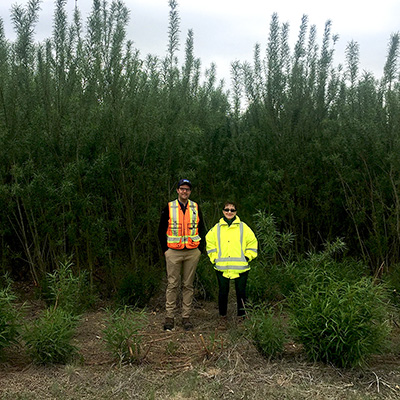2022 Environment & Sustainability Award Recipient
This award is presented to members of APEGA who have demonstrated excellence in the application of engineering or geoscientific methods towards preservation of the environment and the practice of sustainable development.
Biosolids and Willow Trees for a Low Carbon Economy

A few years ago, the City of Calgary’s biosolids lagoons dangerously neared capacity. Built in the 1940s to thicken and store biosolids, the by-products of wastewater treatment, the lagoons could no longer meet the needs of the rapidly growing city.
“Biosolids are nutrient-rich, with nitrogen, phosphorus, micronutrients, and other benefits,” explains professional engineer Catalina Nadeau-Bonilla, leader of operational performance with the City of Calgary. Biosolids from the lagoons are used as fertilizer for agriculture during the spring, summer, and early fall, and accumulate in lagoons during the long Canadian winters.
The city’s Water Services team needed to devise a sustainable way to use the biosolids if it were to save the lagoons.
Working with SYLVIS, a Canadian environmental consulting firm, Nadeau-Bonilla and her team devised a solution with far-reaching benefits. In 2013, they began using the biosolids to fertilize marginal land—sandy soil lacking the nutrients that plants need to grow. As part of this initiative, they applied biosolids to 2,000 hectares of land in a Hutterite community in Rocky View County, establishing a willow plantation on 300 hectares of it.
The willow farm has several benefits. Willows are a rugged and fast-growing species. They can be cut every three years and used as an ingredient in the city’s composting program to improve the composting process and they can be used as food for the animals at the Calgary Zoo. Previously, the zoo acquired willow branches by having a single employee forage for wood around the city. “Now, [zoo staff] come to our plantation, take as much as they need, and have enough for the animals,” she says.
Fertilizing the willow plantation with municipal biosolids creates a carbon-storage sink, meaning more carbon is absorbed from the atmosphere than is released. In 2019, the Government of Canada invested $2 million from the Low-Carbon Economy Fund to support the willow tree project over three years, enabling the team to double the size of the plantation. To meet fund requirements, the project incorporated an ongoing assessment of its performance in reducing greenhouse gas.
The project has prevented the accumulation of biosolids in the lagoons, improved the quality of marginal soils, and produced useful wood, while eliminating greenhouse gas emissions.
“Over the lifetime of the project, we estimate that we’ll eliminate nearly 200,000 tonnes of greenhouse gas emissions—the equivalent of removing approximately 61,000 cars from the road for one year,” shares Nadeau-Bonilla.
For Nadeau-Bonilla, the APEGA Summit Award is an honour and a recognition of her team’s great accomplishment. “This project benefits the community, the environment and, I think, demonstrates the city’s environmental mandate.”
Key members involved in the project’s development include, in alphabetical order:
Kirsten Barlow, E.I.T.
Kevin Colbran, P.Eng.
Myron Flexhaug, P.Ag.
Nisa Jayathilake, P.Eng., M.Eng.
John Lavery, RPBio, P.Ag. MSc.
Catalina Nadeau-Bonilla, P.Eng., M.A.Sc.
Victor Nery, AAg, M.Sc.
Shawn Northwood, E.I.T., B.Sc.E
